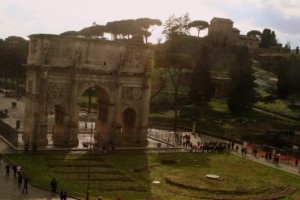text and photos by: Nina Sarmiento
Note: In my previous post, I listed down ways on how to travel for less in Europe.One of which is to just roam around and tour the many fab landmarks, museums and galleries which you can visit either for free or for a token fee.
Last week I reposted The Gypsygals’ Quickie guide to the capital city of Ireland. where I showed that you don’t need to spend a lot of euros to enjoy Dublin!
This week, I will show you how you can have fun in Rome without having to bust your budget.
This is typical scene in Rome. Tables outdoors, heaps of pizza trays and pasta arriving with its waiters mouthing enthusiastic exclamation. The silhouette of beautiful sculptures and churches serve as a backdrop while you enjoy some pasta and coffee after a day of sightseeing .
Rome is over 3,000 years old, which means there’s a lot of history and culture packed in a single place. So every time you wander in the eternal city, you’ll continue to discover something new and exciting.
This city was not built in a day, but you can explore Rome’s tourist attractions even if you only have a weekend to spare. They’re accessible (you can walk or just hop on a Metro). Best of all, you don’t need to spend a dime (or a lira for that matter) to enjoy a walking tour of Rome.
1.The Colosseum: This is the first thing that will spring into mind when one travels Rome. It is so vast, that anyone who visits just has to stop, look and admire the place.
Emperor Vespasian spearheaded its construction around 70AD, the funding came from the spoils of war, and the slaves then provided the labor. The Colosseum was the venue of many gladiator combats centuries ago, main spot for public entertainment. The spectators were segregated by status and sex: the emperor and the vestal virgins had a special box on the ground floor, along with the senators. The aristocrats sat in the second row, the ordinary citizens were on the third, while the uppermost seats were occupied by the women, poor and slaves.
Just like in the movies, the emperor and the spectators have the control on the gladiator’s fate, no wonder the crowd gets very excited, and feels “powerful” whenever the decision is passed over to them.
Today, the Colosseum is less stellar than its older, glorious self. The original seating and flooring were destroyed. The Colosseum suffered from severe fire, earthquakes and looting. The place was actually ‘saved’ from further looting when Pope Benedict XIV consecrated it in honor of Christians martyred and used as kitty food for lions.
Nearest Metro station: Colosseum
2. Roman Forum: While you circumnavigate the Colosseum, you will see a triumphal arch and you are now ready to explore the Roman Forum. Take note that to fully appreciate the historical background of this place, it’s advisable to carry a map with you.
The place is home to some of Rome’s most important structures: the Arch of Titus, the oldest arch in the forum built by Emperor Domitioan to honor Titus’ victory; the impressive Basilica di Massenzio; Tempio di Vesta, dedicated to the vestal virgins who served as priestesses to the ancient Roman goddess of hearth Vest; Rostra, the orator’s place.; and Tempio Di Saturno, ruins of a temple dedicated to Saturn, the ancient Roman god of agriculture.
Nearest metro: Colosseum
3. The Pantheon: From the Roman Forum, walk towards Via Corso, the place to go for Rome’s tourist attractions. This includes the Pantheon, the best preserved building in Rome and stands just at the side of Piazza del Rotonda. Although there is a little to see here, you can’t help but admire on the architectural triumph of this structure. Once inside, the first thing that you will see is the hole at the center of the dome, known as oculus. Daylight that streams through the oculus illuminate the majestic marble-clad interiors and serves as a backdrop for starry starry nights. Rainy days and nights are not a problems. Just look on the floor closely and you can see some holes in there, which drain the water. Brilliant isn’t it?
But in terms of architecture, the one that is still hailed as the best is the dome. The lower part the dome is made of heavy materials supporting the upper part which is made of lighter materials such as pumice. This dome has been an inspiration for the Duomo (in Florence), the Vatican dome and even the White House in the U.S.
The Pantheon is also where you can find the tombs of King Victor Emmanuel II, King Umberto I and wife Margherita, the painter Raphael and his fiancee Maria Bibbiena.
4. Piazza Navona: Before you go back to Via del Corso, you might as well take a breather at the Piazza Navona. Flanked by the fountains, the place is home to some pricey cafés. But you really don’t need to spend anything to enjoy the surroundings.
5. Fontana di Trevi: Go back to Via del Corso, walk your way up and turn right to Via Del Murette where you will see the most beautiful fountain in Rome and where you can imagine yourself as Anita Ekberg in Fellini’s famous movie La Dolce Vita.
6. Piazza di Spagna: Retrace your steps to Via del Corso, conserve your energy as you will need that to climb the famous Spanish Steps. This is a favorite meeting place, especially in spring when the place is abloom with azalea flowers.
Nearest Metro: Spagna
Have you been to Rome? Can you recommend any sites that a traveler can visit for free? Please share it in our comments section 🙂



